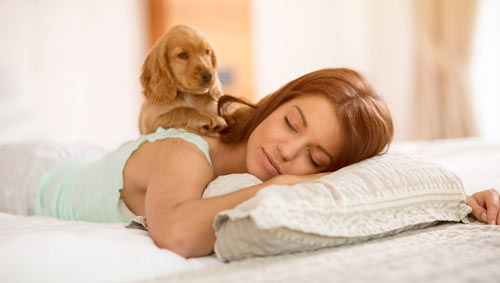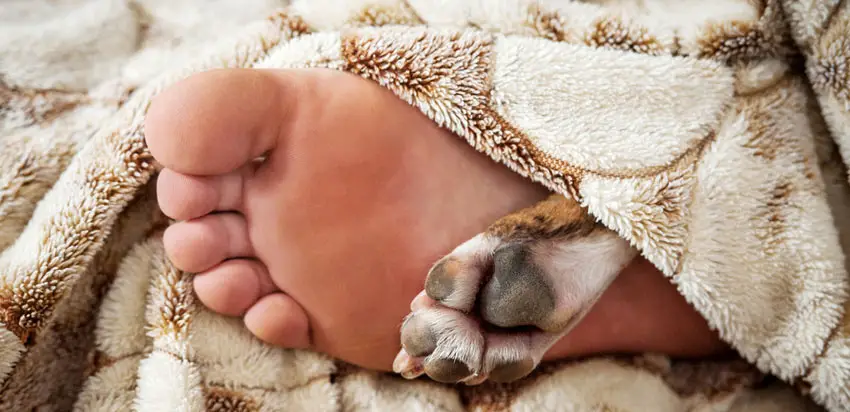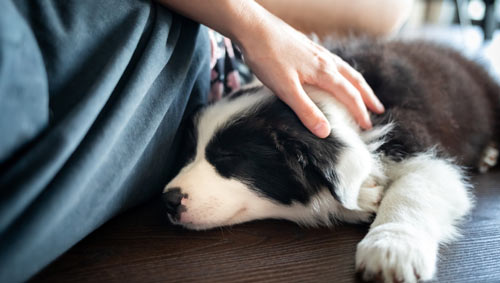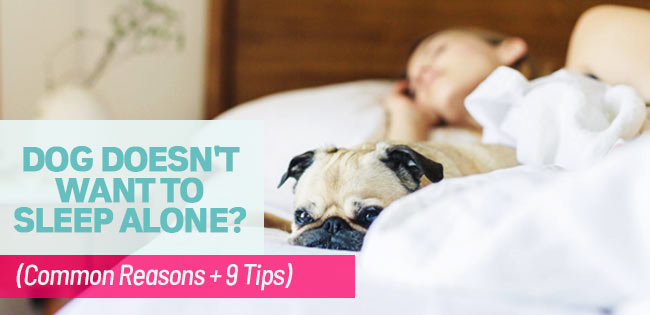Your dog doesn’t want to sleep alone? It’s understandable why pups do this. However, older dogs are also included. This article will cover possible reasons why your canine friend doesn’t want to sleep alone and how to solve this problem.
Dogs often want to cuddle up with you while you sleep. While this is cute, it can be a problematic behavior that may take time to get rid of.
Dogs often find a hard time just being independent and sleeping on their own.
But, as a curious dog owner, you should understand that there are many reasons for this behavior. It could be that they’re scared, anxious, or may have developed a bad habit.
Why your dog doesn’t want to sleep alone
If your dog won’t sleep on his own, here are possible reasons why this is happening
They’re just being puppies
Typically, new puppies suffer from dissociation problems. It can be challenging to leave the one place they know as home, their siblings, and their mother.
But worst of all is adjusting to an entirely new environment, scent, and arrangements altogether.

Undoubtedly, it will be easygoing during the day. However, it’s the nights that bring the howls and cries.
Puppy barking, whining, and crying will be unavoidable for the first few days. And this will be more evident at night because they cannot sleep on their own.
They’re pack animals
You must understand that your dogs aren’t designed to be alone, that’s why dogs understand the pack setting.
When dogs are given birth to, they’re mostly always with their siblings and mum cuddled up in litter boxes or beddings. Hence, changing this arrangement is going to be a different ball game for them.
What you may notice is the fact that they wouldn’t sleep alone. They’re not used to it and will whine and cry when left alone.
Now, it’s quite okay to try and get them as close to you as possible. Maybe let them share your bed with you. But that could ultimately backfire when they get too used to it. Soon you’ll have an adult dog that won’t sleep in its crate or cage.
Your dog my have developed a bad habit
There are a few phases of doggy growth that are very crucial.
First is when you bring in a new dog and when your dog develops an association or anxiety issue.
The two can easily be tackled if you let them into your space while they sleep.
Also, passing the first few nights with your new dog will be the most challenging task. Eventually, they pick up a bad habit, and you’re to blame.
Most dogs will cry and bark half through the night when left alone cause they’re not used to it.
Also, older dogs may do this to get your attention. Eventually, you give in and let them in on your bed space, possibly because you aren’t so comfortable with the irking howls and ear-piercing scratches on your door.
Soon, they get used to the warm snuggles with you for the first 2-3 times, and they like it. It’s going to be difficult to get them adjusted to their crate.
This is because they love it with you on the bed, which may have become a new bad habit for your dog.
You put off the light
We’ve read stories of dogs that went to their crate perfectly but woke up the moment the lights were put off. This is quite a familiar scenario with dog owners, but it’s also one that’s understandable.
Dogs learn by association, and if their association with the dark is with something terrifying like the sound of thunder or something they find scary, they will live with that fear for some time, moving forward.
So, it’s easy to understand why your dog may want to get on the bed with you or sleep close to you at the very least when the lights are turned off.
This problem can get complicated as you will have to find out what your dog/puppy associates darkness with.
But in the meantime, you can have them stay on the bed with you when the lights are turned off.
You dog may have separation anxiety
Dogs are affectionate animals and will sometimes develop a strong bond that they find difficult to part with.
This bond could be anything from their human owners to food and toys.
According to Animal Behaviorist, most dogs often associate everything they value in their life — company, play, food, going for walks — with when people are around”
Here are symptoms of separation anxiety in dogs:
- Urination and going potty inside the house and outside of their regular walks.
- Biting and destruction of household furniture.
- Changes in routine.
- Incessant crying, whining and crying when their owners are not around (more evident at night and during working hours).
- Stereotyped behaviors, i.e., repetitively doing something without a specific reason. Moving round in circles, chasing after their tail and “biting flies” are quite common with dogs that are suffering from separation anxiety.
- Coprophagia (ingestion of own feces).
Should I let my dog sleep alone?

We often get these sorts of questions from dog owners if they should let their dogs sleep alone.
Firstly, you need to understand that you’re not always going to be available for your dog, so showing them how to be independent is crucial.
Having your dog sleeping by you isn’t entirely a bad idea.
In fact, there’s nothing inherently wrong with this.
However, at some point, you may want to have your space to yourself, and your dog will need help understanding this.
So teaching your dog to sleep on its own is very highly pivotal.
How do I make my dog (pup) sleep alone?
Showing a puppy how to be independent and sleep on its own can be relatively less complicated. However, older dogs will require more time.
For puppies, it all starts from the moment they first set paws in their new home. Everything from there on has to be dog autonomy-inclined.
This includes everything from showing your new pup where to poop to letting them know their surroundings. But most importantly, letting them know where they’re going to sleep.
Typically, the first nights will be a nightmare for most dogs as they will cry, howl, and whine mostly through the night. It’s because they’re now alone and not with their siblings or mother.
Prepare their bed
If you’re going to have any success making your new pup sleep on its own, it’s all going to boil down to making their bedding as comfy as possible.
When your new pup just arrives, you want to introduce them to this place during the day. Have them explore it on their own and throw in some toys to attract them
During the night when it is certain they’ll cry, you can fill their crate with treats, chew toys, and a towel that has your scent. This will make it easier for them.
Think proximity!
For most dogs, you can put their bed or crate just beside yours, so they know you’re there for them. If they’re still not okay with this, you can have a hand down to comfort them each time they start crying.

This should work for most puppies; you can increase the distance with time.
However, you can try something new if you’re different from the type who would want your pup to share the same room space with you.
When picking up your pup for the first time, bring a towel with you and have the breeder rub it on the pup’s mother. Then, put this towel in your puppy’s crate when they’re about to sleep so they can perceive the scent of their mum.
This is because pups will mostly cry and whine because they’re scared, and this scent will only reassure them that they’re not alone.
Praise and encourage them
When making your new puppy go into their crate on cue, constantly praise them. A simple “Good boy” or “Good dog” should do. Also, treat them each time they successfully enter the crate and lay.
Soon enough, they’ll be comfortable going in there on their own when it’s nap time.
Teaching older dogs to sleep on their own
Teaching older dogs to sleep on their own can be really difficult if you don’t do it from the beginning. However, some dedication and patience on your side should do the trick.
The first thing you want to take off the list is the fact that your dog is not suffering from separation anxiety. If that’s the case, you may have to see an animal behaviorist.
Ideally, separation anxiety will wear off on your dog naturally in some cases. Still, an animal behaviorist should help you with this issue.
But if you’ve successfully ruled out separation anxiety or any mental-related problems, it’s time to teach your dog to sleep independently.
Build a routine
Dogs are keen on routines and follow them with extreme dedication. As such, if you want to teach something to your dog, you need to create a consistent pattern.
Being specific with feeding, playing time, and bedtime is pivotal for this to work.
Once you’ve consistently steered through to the last activity on that routine, bedtime, you should make it consistent. This way, your dog knows when it’s time to sleep.
Usually, a command word triggers this activity. Maybe, “bedtime” or “bed” followed by pointing to its crate or bed space should work.
Only praise and reward them when they get in and lay down.
Also, this activity should be followed by switching off the light afterward.
And if your dog should try to get out after initiating the command word and praising later, you should discourage this behavior.
Be consistent with it; soon, your dog should be comfortable going to bed on its own.
Tire them out
An energetic dog will find it hard to go to sleep, let alone sleep on its own. As such, they’ll cry, scratch, whine and howl when you try to put them in their crate.
One trick that works is tiring them out. Why does this work? When dogs get tired, they just want to rest and will do that, forgetting they have a problem sleeping on their own.
You can do this 30 mins before bedtime. Go on an extra long walk/jog with your dog. Or better still, play with them for extended periods until they wear out.
Now take them to their crate and say “bedtime,” followed by pointing at the crate area. Chances are, your dog won’t hesitate as it is already tired.
Once your dog is inside, praise him and switch off the lights.
Use natural remedies
Anti-anxiety chewables often contain ingredients like melatonin, chamomile, valerian root, CBD, etc.
You can administer this 30 mins before bedtime to help calm your dog down.
To further add, always check dosage and ensure to get one for puppies if your pooch is still a pup.
Create a replica of yourself
If you’re trying to get your dog to sleep alone without you, you’ll need to think outside the box most of the time.
Making a worthy companion for your dog at night is crucial.
- You can use a hot water bottle wrapped with a thick towel and place it beside your dog.
One thing that draws your dog to your bed every time is the warm and cozy feeling they get when they lay beside you. The good thing is you can always recreate this and use it to your advantage.
Using a hot water bottle, fill it with hot water and wrap it with a thick towel. Have this placed beside your dog. This will replace the warmth they feel when they lay with you on the bed.
- Place an old shirt with your scent in their crate.
Most times, all a dog needs is the assurance that you’re present with them.
You can always trick them into thinking this way by staying with them until they fall asleep and then gently slide a shirt of yours into the crate.
This way, when they wake up before time, the shirt with your scent will reassure them of your presence.
See an animal behaviorist or vet
Suppose your dog still maintains this behavior after all this. In that case, you’ll have to visit an animal behaviorist for consultation as it could be something serious like separation anxiety or mental problems. Whichever it is, your vet should be able to troubleshoot this problem.
Final thoughts
Dogs love their human companions and will sometimes develop an issue in their absence.
For example, if your dog doesn’t want to sleep alone, it could be that they’re scared or just putting up a bad habit.
Either way, you can have this sorted out if you follow the proper steps, and with time, your dog should sleep on its own just fine.
Continue Reading: Find Out Why Your Dog Sleeps With His Bum in the Air


